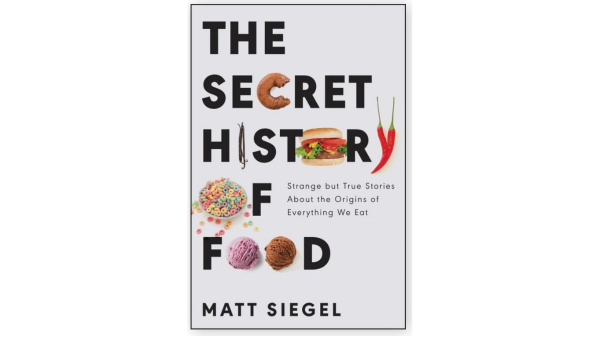There is a genre of books about food that aren’t much more than a string of fascinating trivia.
But usually these books are enjoyable and informative.
Such is the case with Matt Siegel’s Secret History of Food.
It’s a collection of snapshots of different food items, with anecdotes, history, and a description of the current scene.

Like many books of its kind, this one has plenty of material on how things are not what they seem on the grocery shelf.
Honey, for example, is not necessarily what the jar is telling you it is. Filtering, which can be beneficial to remove wax and insects parts, is also used to edit out the product’s pollen, eradicating traces of its origin. As for regulation, “we’re basically on a honey honor system,” Siegel writes.
His approach to apples is a bit roundabout: it’s in the context of pie, once a much more important menu item than today. In old England, pies could contain all sorts of things, sweet and savory—everything from swans to lamprey’s blood. The crusts were thick and often inedible, serving more as packaging than food.
Pie came into its own in early America. Flour was scarcer, so cooks were motivated to roll thinner (and more palatable) crusts.
Pies took off. “This country was founded by men who had pie for breakfast, pie for dinner, pie for supper; in addition, they usually had a slice or two before going to bed at night,” said a 1922 article in The Nation.
This explains a joke I never really understood. Although it’s too long to tell in full here, the punchline is, “A Yankee is someone who eats pie for breakfast.”
Pies frequently meant apples, which took off in the New World. “Between the years 55 and 1620, there were roughly thirty-four new types of apples documented in Europe. But the colonies gave birth to some seventeen thousand new varieties, not including the countless experiments that weren’t particularly appealing or worth cataloging,” writes Siegel.
Siegel finds chiles rather perplexing—that is, why anybody ever developed a taste for them. “Bite into a habañero or order your food ‘Thai hot,’ and your body essentially thinks it’s being attacked by a chemical weapon.”
My personal answer comes from an experience during a trip to India: I was eating outdoors, in rather primitive conditions (banana leaf plates). I didn’t finish all of my food. I noticed that the flies were landing on the rice, but they weren’t landing on the curry.
Siegel’s chapter on tomatoes focuses on how people used to think they were poisonous (they’re part of the nightshade family) and whether they’re a vegetable or a fruit.
They’re a vegetable, Siegel tells us. In an 1887 tariff ruling over a dispute, the Supreme Court issued that ruling because they “are, like potatoes, carrots, parsnips, turnips, beets, cauliflower, cabbage, celery, and lettuce, usually served at dinner . . . and not, like fruits generally, as dessert.”
Now you have an answer to that old conundrum.
Vitamins don’t fare so well. “As for some of the supplements sold in supermarkets, DNA testing has shown that many of them contain none of the ingredients they claim to. . . . So vitamins are good for us or they kill or they’re not even vitamins.”
In any case, The Secret History of Food is a delightful stroll through some of the ways and byways of the things we eat. You’ll definitely pick up a few amusing bits of trivia here.



